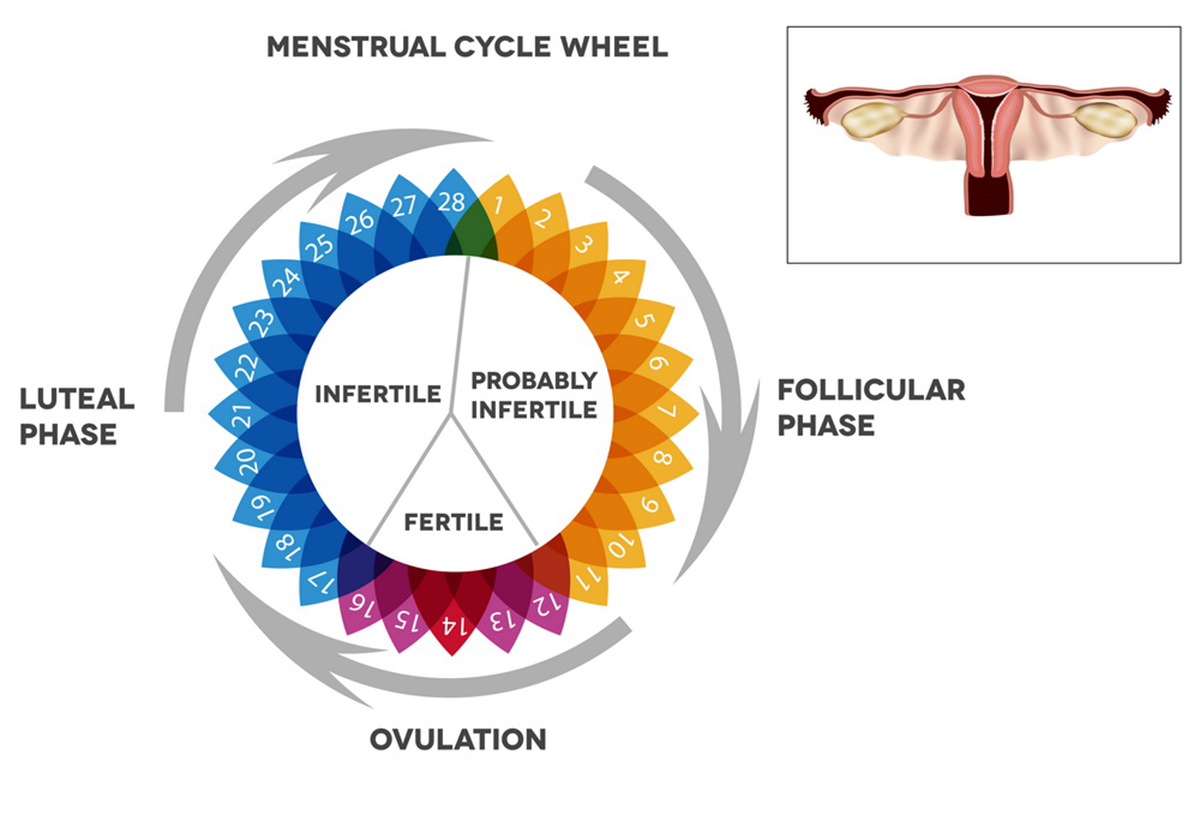Periods — most women see them as an annoying phenomenon. They're mildly annoying for some, and devastatingly annoying to those who have to take painkillers and call in sick every month. The average woman has about 300 menstrual periods in her lifetime. Most of us have a rough idea of the length of our menstrual cycles, and we also know that we ovulate somewhere between two periods. Most of all, though, we know that we don't really like menstruating.

Then, when we decide to try to get pregnant, a whole new world opens. Most couples who are ready to add to their family would like to conceive as soon as possible, and for that they need to find out when the female partner is fertile. This adventure leads many to seek out new information about the menstrual cycle.
Your Menstrual Cycle
Your menstrual cycle has two phases: the follicular phase and the luteal phase. Follicles mature during the first stage and one follicle starts dominating, (usually) culminating in the release of one egg during ovulation. The follicular phase is controlled by FSH, follicle stimulating hormone. While follicles compete for domination, the lining of the uterus also grows in order to provide a cushy environment for the egg if it is fertilized.
Ovulation is triggered by LH, luteinizing hormone. This hormone is suppressed by estradiol during the follicular phase, but when that hormone reaches certain levels estrogen starts dominating instead. This, in turn, triggers the release of LH from the pituitary gland. The LH surge signifies the start of ovulation, and it's this surge that you detect if you use ovulation predictor kits. Once it takes place, you have 12 to 24 hours before the egg starts disintegrating.
See Also: Implantation bleeding or period?
Though ovulation itself lasts no longer than a day, a woman's fertile window is considerably longer.
That is because sperm cells have the ability to survive within the female reproductive system for quite a while — up to five days, in fact. Sperm that are already present when the egg is released during ovulation get a chemical signal that they can stop waiting and start fighting to win the "egg race". At the same time, couples who have intercourse the moment an ovulation test detects the LH surge also have a good chance of getting pregnant during that cycle.
How To Use Your Knowledge Of The Luteal Phase To Get Pregnant (Or Not)
The Luteal Phase
The luteal phase is the second part of your menstrual cycle — the post-ovulation phase. When an egg is released from the dominant follicle, the tissues that are left over still have a very important role to play. They turn into the corpus luteum, which produces the progesterone that is key to your luteal phase. This in turn leads to the production of estrogen. The production of these hormones leads to the suppression of LH and FSH, which causes the corpus luteum to disintegrate if you don't get pregnant. That disintegration causes progesterone levels to fall, which induces menstruation.

The corpus luteum doesn't disintegrate if you get pregnant, however. The outer layer of the fertilized egg — which will later become the placenta — produces human Chorionic gonadotropin in that case. This is the hormone that pregnancy tests look for, and it is also really similar to LH, so it keeps the corpus luteum intact. The corpus luteum can then continue to produce the progesterone that is necessary to maintain pregnancy.
OK, How Can I Use This Information?
The luteal phase begins after ovulation occurs. Knowing when you are fertile and when you are not helps you get pregnant as quickly as possible when you are trying to conceive. It can also help you avoid pregnancy naturally, but be careful — while natural family planning methods can be very successful, they aren't fail-safe. Just like other forms of birth control, they work well only if you use them just like you should.
- The average luteal phase lasts 14 days. The length of the luteal phase varies less than the length of individual women's menstrual cycles. While your cycle can last anywhere from 24 to 32 days and still be considered normal, your luteal phase isn't going to be much longer or shorter than 14 days. Do you know when your next period is due? Subtract 14 days, and you'll have a really good idea as to when you might be ovulating.
- Your cervical mucus changes throughout your menstrual cycle, along with the hormones that dominate. You'll have menstruation, then next to no mucus, then more mucus, and then large amounts of thin, stretchy mucus. That "egg-white mucus" indicates you are very close to ovulation and might well be fertile. Once your luteal phase starts, your cervical mucus will be creamy and white in color. This non-fertile mucus keeps sperm out.
- Once your luteal phase begins, your basal body temperature rises by one half to a degree Fahrenheit or a quarter to half a degree Celsius. You can measure your BBT daily first thing after waking up to find out when you ovulate.
- If your luteal phase turns out to be much shorter than 14 days, you might have trouble conceiving. In that case, make an appointment with your doctor.
Those who are using natural family planning to avoid pregnancy need to know when the luteal phase begins, so they can be sure there is no chance of pregnancy at that point. Advocates of this method say that it is as reliable as any other contraceptive, proving it is used correctly.
See Also: Understanding Your Fertility
Luteal Phase Defect
A Luteal Phase Defect (LPD) is a condition in which a woman's luteal phase is too short for pregnancy to occur. Women who have a Luteal Phase Defect usually have no problems with ovulation, and eggs can be fertilized. They can still not get pregnant, because fertilized eggs do not have the time to implant into the lining of the uterus before menstruation comes along to flush the uterine lining including the egg out.
A Luteal Phase Defect occurs if the corpus luteum does not produce adequate amounts of progesterone, or if the uterine lining does not respond to that progesterone well. This can happen as the result of endometriosis, anorexia, obesity, Polycystic Ovary Syndrome, thyroid problems, or Hyperprolactinemia (that's an excess of a hormone involved in the production of breast milk).
- Photo by shutterstock.com
- Photo courtesy of Daniele Pieroni by Flickr : www.flickr.com/photos/lastquest/1473383832


Your thoughts on this